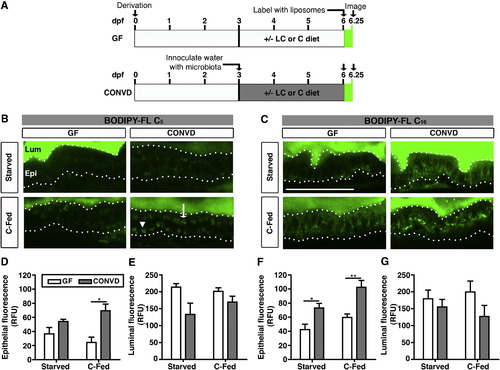Fig. 1
- ID
- ZDB-FIG-121023-26
- Publication
- Semova et al., 2012 - Microbiota regulate intestinal absorption and metabolism of Fatty acids in the zebrafish
- Other Figures
- All Figure Page
- Back to All Figure Page
|
Fatty Acids Accumulate in the Intestinal Epithelium in the Presence of Microbiota and Diet (A) Schematic of BODIPY-FL delivery assay in gnotobiotic zebrafish. Zebrafish derived germ free (GF) at 0 days postfertilization (dpf) were either reared GF (top) or inoculated at 3 dpf with normal microbiota (conventionalized, CONVD; bottom). From 3 to 6 dpf, fish were either starved or fed a control (C) or low-calorie (LC) diet (see Table S1). At 6 dpf, zebrafish were incubated with BODIPY-FL liposomes for 6 hr and imaged or fixed for later imaging. (B and C) Representative confocal images of the intestines of live 6 dpf GF and CONVD zebrafish incubated with BODIPY-FL C5 or C16. Scale bar, 50 μm. (B) The intestinal lumen (Lum) and epithelium (Epi; bounded by dotted lines) of GF and CONVD zebrafish are indicated. The epithelium shows apical (white arrow) and basolateral accumulation of lipid droplets (white arrowhead) labeled with BODIPY-C5. (C) Incubation with BODIPY-FL C16. (D–G) Quantification of total epithelial (D and F) and lumenal (E and G) fluorescence expressed in relative fluorescence units (RFU) in zebrafish incubated in BODIPY-FL C5 (D and E) or C16 (F and G). Values represent the means ± SEM from three independent experiments: p < 0.05; **p < 0.01. |

